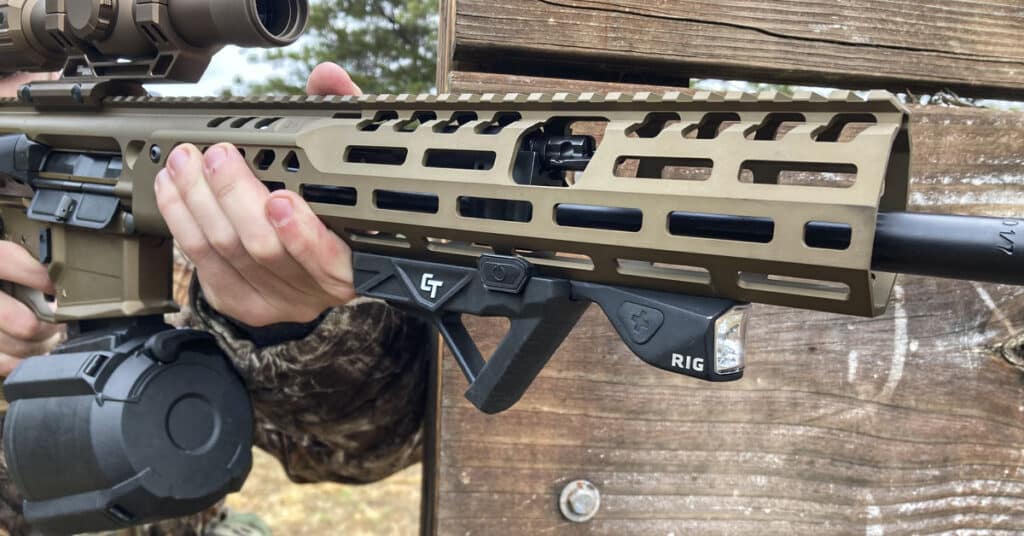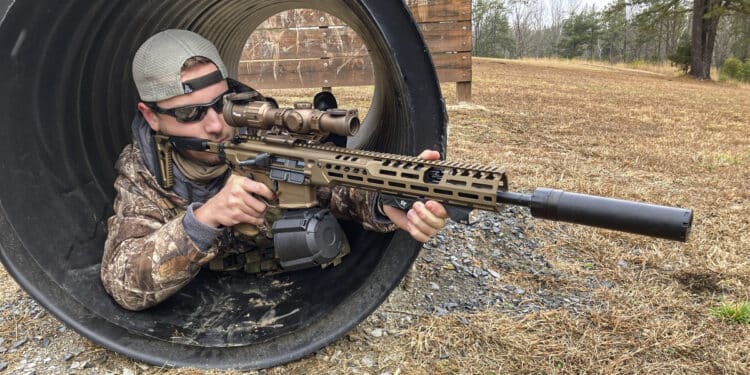By Todd Burgreen –
SIG Sauer is at it again. The company is recognized as an industry leader in the development and manufacturing of rifles, submachine guns, belt-fed machine guns, handguns, optics, suppressors, ammunition, and more. This leads us to SIG’s latest rifle offering—the MCX SPEAR LT. The MCX is a new approach to the carbine platform that blends caliber adaptability with feature configurability without sacrificing reliability.
One thing immediately came to mind when the MCX SPEAR LT was introduced. How could the SPEAR LT be worthy of supplanting the original 2015 MCX and its 2017 MCX Virtus successor? SIG took a raft of grief from the public for releasing the upgraded MCX Virtus with some consumers crying foul over their perceived role as platform beta testers. So, SIG releasing a third generation of the MCX is bound to irritate past generation MCX owners.

In the end, though, SIG can’t be expected to stop developing the platform when faced with advances in technology and materials, as well as lucrative procurement opportunities that would drive the development of any platform forward.
In the end, SIG is willing to endure the criticism it might face for advancing the MCX platform with another generational release that further improves the carbine’s ability to adapt to a wider range of missions, as the SPEAR LT does.
According to SIG, the original MCX spawned from a SOCOM request to develop a 7-pound, compact multi-caliber adaptable rifle that would be predominantly operated suppressed. The same military input has driven all three MCX generations. All of the MCX-series improvements were driven by additional tier one DOD unit contract requests that sought to increase accuracy, modularity, and durability. The public is fortunate to benefit with MCX civilian models made available.
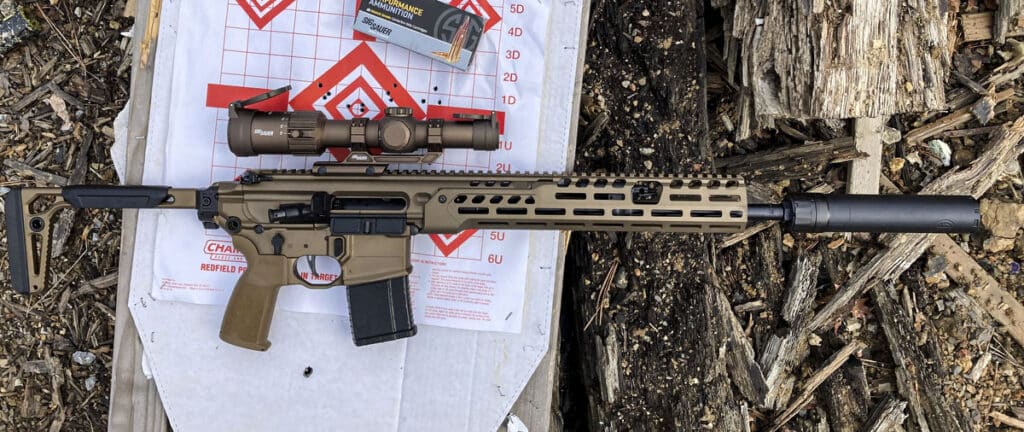
Inevitable Evolution
“The MCX SPEAR LT is an evolution of the MCX VIRTUS,” says SIG Sauer’s Media Relations Manager Michael Marotte, “brought about through competition in U.S. Special Forces and allied special forces weapons contracts.”
Addressing the differences between MCX Virtus and MCX SPEAR LT, Marotte says, “Externally the biggest difference is the handguard, we went lighter and slimmer and thus more ergonomic. Doing this typically sacrifices the rigidity needed for laser aiming modules, however we have maintained the rigidity by adding two retention screws that attach the handguard directly to the upper receiver.”
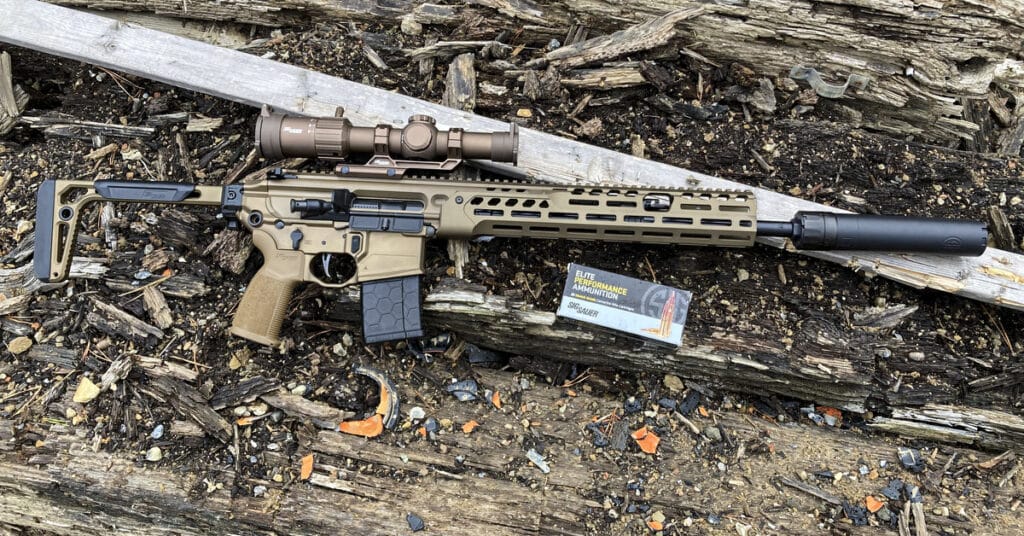
He says the second large difference is the addition of an ambidextrous bolt-catch and bolt-release on the right side of the firearm. Push up to lock the bolt to the rear or down to release it.
The folding stock and modularity are big indicators that the MCX is not another AR platform. The MCX bolt carrier group is different than an AR’s. The initial user’s request to use a folding stock in lieu of a typical AR buffer tube setup required a new bolt carrier design. SIG installed dual recoil springs above the bolt carrier group. Due to the recoil spring placement, the charging handle sits slightly higher on the MCX receiver compared to an AR. Not only did the dual recoil springs enable the use of a folding stock, but it provides other benefits in terms of a smoother and softer recoil impulse, elimination of buffer tube wear associated with AR piston driven rifles, and an increase in overall reliability and durability. The intent to operate almost exclusively suppressed and to accommodate various calibers using different barrel lengths (including sub-10-inch barrels) meant the MCX would use a self-regulating, short-stroke operating system.
Generations
SIG’s designers needed to meet a 50,000-round-count endurance criteria for the upper receiver to satisfy the initial solicitation that brought the MCX to life. The MCX Virtus takes this even further with a 20,000-round endurance requirement that excludes replacing normal wear and tear components during the endurance test. This should allay any concerns about its durability in terms of wear and “loosening” up with use. The MCX SPEAR LT follows this path.
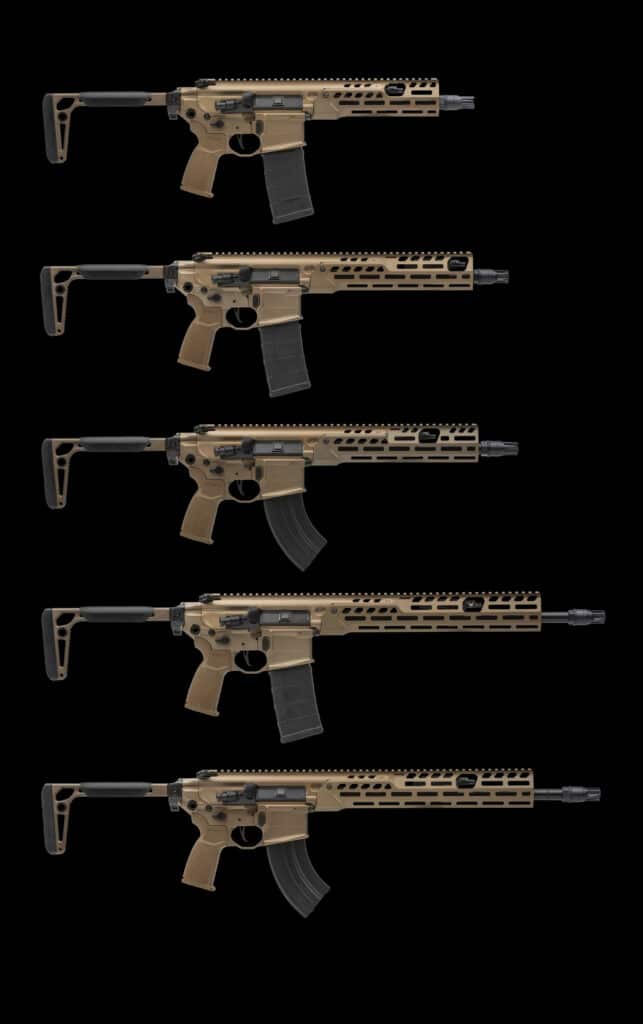
Obviously, quality materials are a must along with a full understanding of high wear parts on the rifle. SIG has designed the MCX with certain key components upgraded from aluminum to steel; these parts are also easily replaceable. For example, the cam path and feed ramp inserts. The charging handle latches move over steel pins as opposed to aluminum pins. MCX barrels are hammer forged and receive a nitride treatment for increased barrel life.
The original MCX to MCX Virtus improvements consisted of a tapered lug bolt group, a two-stage SIG Matchlite Duo trigger, thicker receivers and barrels (the reason why MCX and MCX Virtus barrels and bolt groups are not interchangeable), M-Lok handguard and modified gas port locations. The MCX SPEAR LT ups the ante even further over the MCX Virtus. SIG’s Marotte points out that with the SPEAR LT, “the bolt carrier group has had a minor redesign, moving the firing pin safety latch from the 12 o’clock position in the recoil assembly to a 9 o’clock position on the carrier. This reduces the energy needed to defeat the latch, allowing for the use of aftermarket AR triggers. It also improves performance and reliability with surplus, hard primer 7.62×39 ammo.”
The SPEAR LT has a lightened and recontoured handguard with attachment screws for additional rigidity. Barrel manufacturing focused on maintaining accuracy, even with the SPEAR LT’s slimmer profile barrel. About a pound was shaved off the MCX SPEAR LT compared to MCX Virtus. Other features of the MCX SPEAR LT include an ambidextrous bolt catch and bolt release on its lower receiver. The MCX SPEAR LT is fully ambidextrous—selector switch, charging handle, bolt, and magazine release. A lever on the right side of the receiver above the magazine release acts as a supplemental bolt catch and bolt release.
The MCX SPEAR LT features coyote anodized finish, including minimalist stock with button release for maximum compact foldability. The return to AR15-style trigger compatibility will be well received. The MCX SPEAR LT brings the long-anticipated addition of the 7.62×39 caliber to the MCX family.
Modularity
The rifle’s caliber, barrel length, forend, and buttstock are all easily interchangeable. Anecdotal stories are shared by SIG representatives of how the SIG MCX would be submitted for certain military solicitations with all associated gear arriving in one hard case. We’re talking about different calibers, barrel lengths, handguards, optics, and suppressors—all made by SIG, by the way. We’re told that in these situations, competitors would be wheeling in multiple cases of gear and setting up multiple upper receiver configurations to meet the desired trial parameters instead of just switching out specific components as needed.
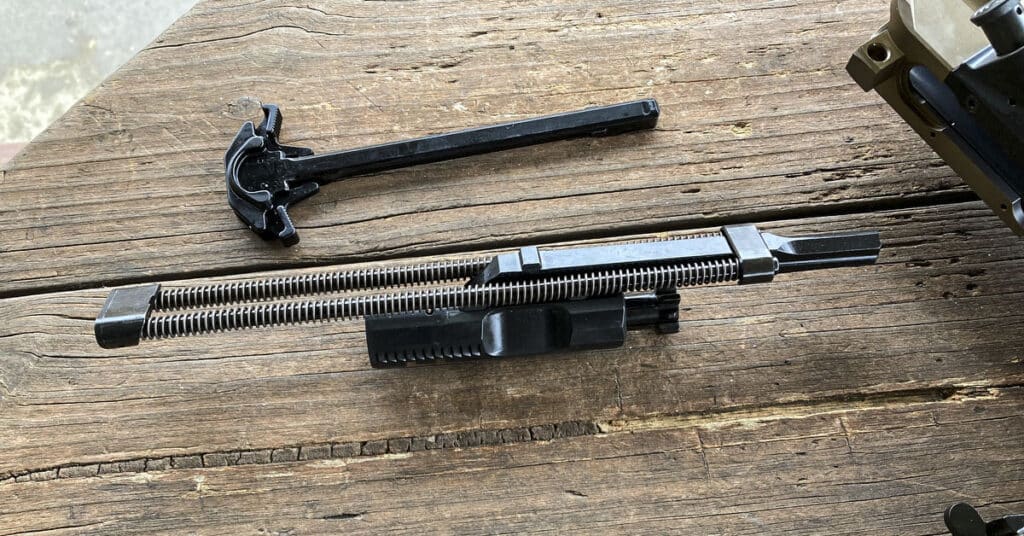
The SIG MCX SPEAR LT can be viewed as a fresh design in a market dominated by the AK and the AR. The SIG MCX represents a new age of rifle modularity. Caliber change between 5.56mm and 300AAC is a simple matter. The fact that the 5.56mm and 300AAC share the same magazine and bolt group is the foundation for their close compatibility. Removing the forend exposes two captive T27 Torx bolts. Loosening these allows the barrel and gas piston to be removed. The new barrel and gas piston is then installed with the two T27 Torx bolts tightened to 60-inch pounds. The whole process is as simple as reading it. Caliber changes between 5.56mm/300AAC and 7.62×39 require a bolt change and the barrel kits will come with the bolt.
Ancillary Support
A SIG SLH 7.62 suppressor was chosen for use with the MCX SPEAR LT. SIG’s SLX/SLH QD muzzle device arrives pre-installed on the MCX SPEAR LT. The SLH uses SIG’s new clutch-LOK QD mounting system. SIG has put as much thought into the SLH 762 suppressor as the SPEAR LT. Not only is hearing protection addressed with the SLH, but so is th4 management of toxic fumes associated with back blast. MIT computing power was purchased to come up with a monolithic baffle design to keep fumes out of the operator’s face. Traditional CNC machining could not cope with the intricate metal work needed to comply with the blueprint, so 3D printing and DMLS manufacturing methods are used. The SLH remained mounted on the SPEAR LT for the majority of our evaluation.
The SIG theme was continued with a SIG Tango-MSR LPVO 1-6x24mm optic. The MSR LPVO offers a 1x illuminated reticle setting for quick target acquisition at close range with both eyes open. A quick turn of the eyepiece to 6x enables longer precision shots. The optic is loaded with high end features such as an adjustable illuminated BDC6 MOA reticle, and low dispersion, high transmittance glass for outstanding light transmission and clarity.

The MCX SPEAR LT handguard’s M-LOK capability allows mounting Crimson Trace’s recently introduced RIG (Rapid Illumination Grip). The RIG combines the ergonomic advantage of an angled foregrip with a 500-peak-lumen weapon light into one sleek, effective device. As a side note, the RIG is ideal for braced pistols requiring a light. The angled foregrip is not considered a vertical foregrip which is a big no-no on braced pistols due to Federal regulations.
Ammunition tested with the SIG MCX SPEAR LT was a combination of multiple 5.56mm/223Rem loads from SIG, Black Hills, and Hornady. No load tested produced greater than 1.5-inch groups at 100 yards. Our top performer, SIG’s Elite 77 grain Match punched three rounds into a 0.5-.75-inch groups. Pretty impressive considering the 1-6x optic mounted and the idea that the MCX SPEAR LT is a fighting rifle, not a match target rifle affair, making this performance even more impressive.
PERFORMANCE
| LOAD | VELOCITY AVG. | ACCURACY (Avg.@100yd) |
|---|---|---|
| Black Hills 69gr Match | 2705fps | 1in |
| Hornady 55gr TAP | 2935fps | 1.33in |
| SIG Sauer 77gr OTM | 2731fps | 0.75in |
| American Eagle 62gr FMJ | 2980fps | 1.66in |
RANGE EVALUATION
The minimalist nature of the SIG folding stock caused some initial skepticism related to the rifle’s ergonomics and effectiveness. This was quickly forgotten once the shooting started. The folding stock proved rock solid and provided a solid cheek weld for use with optics; kudos to the SIG design team for this. The MCX SPEAR LT lived up to the task of being an ergonomic, well handling rifle. Drills moving around barricades and training evolutions involving firing and evacuating from vehicles clearly bore this out. The handy MCX is what individuals will choose to work with in such environments. Over 500 rounds were fired for this T&E. The piston driven MCX proved utterly reliable with only minimal effort given to wipe down bolt carrier group and lubricate sporadically.
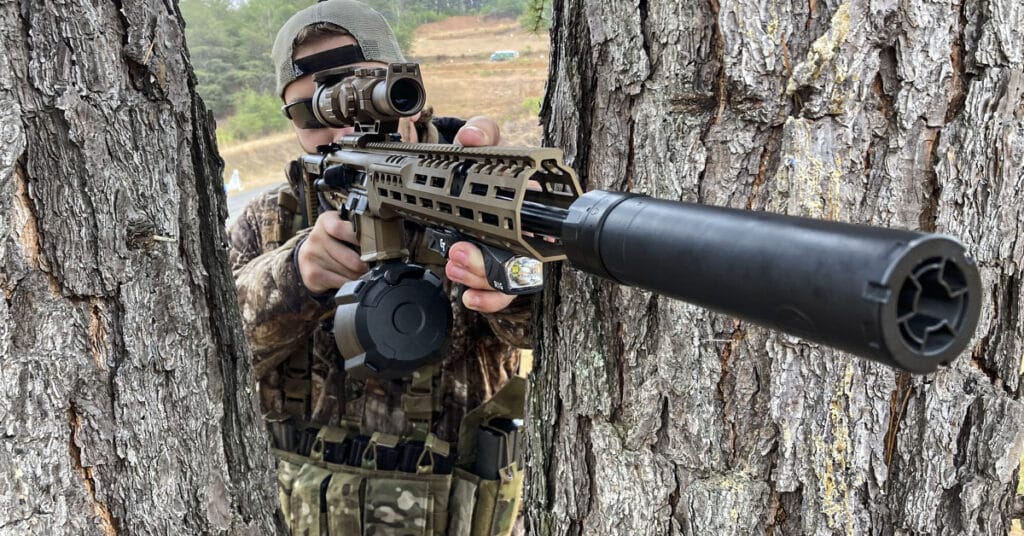
The SIG short-stroke gas piston operating rod system proved its worth, keeping the bolt carrier group cooler and cleaner compared to direct impingement rifles, even with the SIG SLH suppressor mounted. While not trying to be unrealistic or overly harsh, the SIG MCX was exposed to a high volume of fire typical of team tactics bounding drills. The method was employed to confirm that, beyond a doubt, the SIG MCX delivered as advertised under the most adverse operational conditions, including with a suppressor mounted. A Magpul PMAG D-60 drum magazine was used during portions of our evaluation. This allowed the MCX SPEAR LT to shine when faced with a harsh, no-breaks firing schedule. We appreciated how well the MCX SPEAR LT forend shielded the shooter’s off-hand from the heat coming off the barrel. The Crimson Trace RIG also held up well under the semi-abusive environment.
With the SIG MCX SPEAR LT, SIG finds itself in an advantageous position by being a total system provider — weapons, optics, suppressors, ammunition, and other accessories. At the beginning of this article, I openly questioned if the new, third generation MCX SPEAR LT was really necessary. The real shame would have been if the improvements represented in the MCX SPEAR LT had been withheld. Performance is the quickest way to appeal to the shooting public…the MCX SPEAR LT will have no problem proving its worth.
SPECIFICATIONS
| Make: | SIG Sauer |
| Model: | MCX SPEAR LT |
| Caliber: | 5.56mm, as tested (300BLK, 7.62×39 available) |
| Barrel: | 16in 1:7in (other lengths available) |
| Overall Length: | 34.3in (stock extended) |
| Weight: | 7.5lb |
| Action: | Short-stroke, Gas-piston |
| Capacity: | 30rd AR-style Mags |
| MSRP: | $2799 |
| URL: | sigsauer.com |
